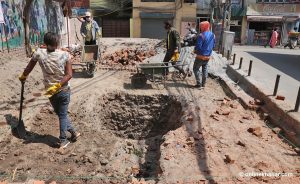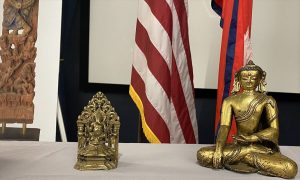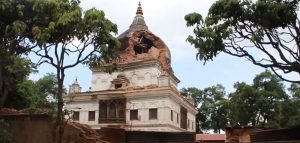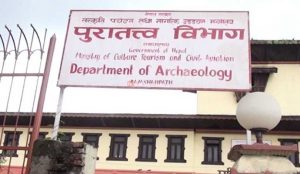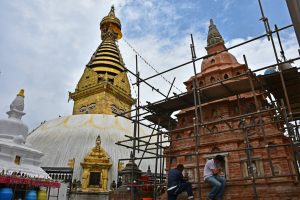On December 22, 2021, a group of people digging the road to lay down the sewage pipes in Patan of the Kathmandu valley uncovered a six-foot inscription from the Lichhavi era buried underneath. The inscription was then taken to the Department of Archaeology for reading.
Sadly, the department currently does not have its own people to read and interpret such texts. It called Shyam Sundar Rajbanshi to come over and take a look at the inscription.
A month before that, another group of activists uncovered a Malla-era inscription from Bhotahiti of Kathmandu. They also knocked on the doors of the DoA for the reading of the inscription. Ultimately, they too had to reach out to Rajbanshi as the department could not help.
Both the scenarios highlight one of the underlying problems of the department set up to preserve and protect the archaeological sites of Nepal: a lack of in-house skill to interpret historical evidence. As Shyam Sundar Rajbanshi remains the solely authorised epigraphist of Nepal for now, he is also concerned that after him, there is practically no one that can uncover Nepal’s rich history that is left scattered beneath the earth.
Following the father’s footsteps
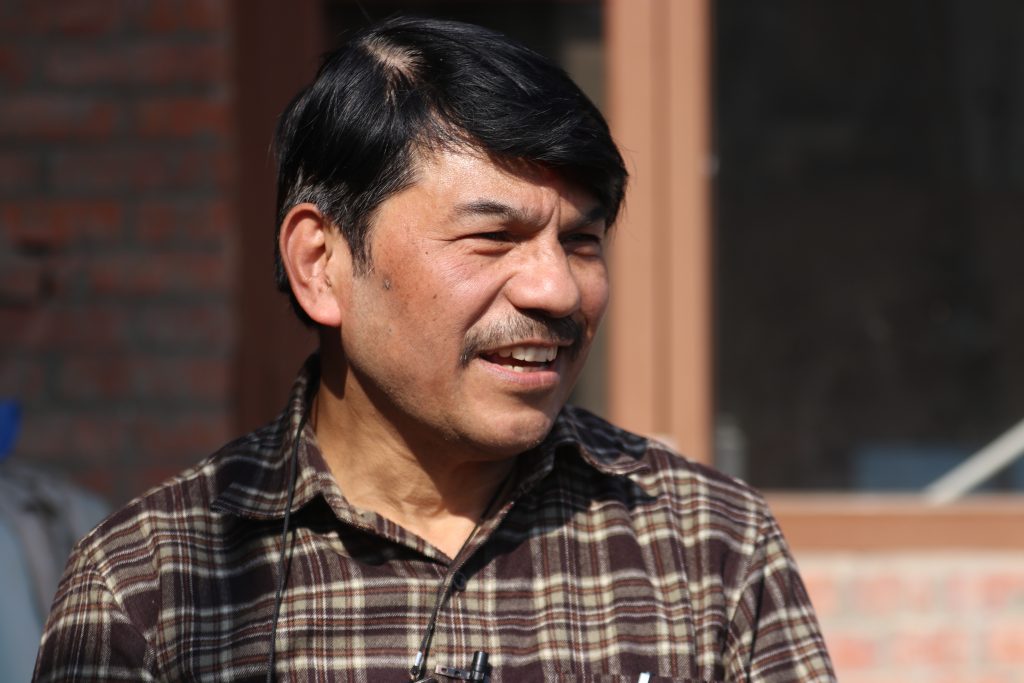
Son to Shankar Man Rajbanshi, a veteran historian and epigraphist, Shyam Sundar Rajbanshi felt a natural inclination towards history and culture from a young age. “I always had interests in history; it fascinated me and I always yearned to learn more.”
Spending a lot of his time with his father, he got a chance to learn from him in his formative years. All of that, he says, helped him become an irreplaceable asset in the discipline of Nepali history today.
“My father was not just a historian but also an astrologer by practice. Together with him and under his guidance, I learned a lot about how inscriptions are translated,” Shyam Sundar Rajbanshi shares, “I also got the opportunity to learn closely about the methods and approaches that were used by experts like Dhana Vajra Bajracharya, Naya Raj Panta, and Hem Raj Shakya to read scripts on the inscriptions and convert dates. I also went over every book translated by them, especially by Bajracharya, to get more insight.”
He got interested in reading inscriptions when there was no academic platform to learn the skill. Self-taught Rajbanshi started working professionally in 1983.
In retrospect, Shyam Sundar Rajbashi believes, it was both his interest and his father’s status in society that drove him towards the reading of inscriptions. “As my father was such a personality already, people suggested that at least one of his sons should be trained to read the inscriptions to lead the wagon after him. So when I was looking for a job, with everyone insisting, I landed a job at the Department of Archaeology in a very early stage.”
Initially, he worked at the Patan Museum as a script reader and later was transferred to the department to fill the position left by Hem Raj Shakya, making himself the sole script reader at the office after him. “Further down the line, I was also posted in Hanumandhoka Herchaha Adda, but because there was no one, they transferred me back to the department.”
In the meantime, Shyam Sundar Rajbanshi completed his BA and MA in history and diploma in culture.
Fears for the future
Rajbanshi, although he got skilled in epigraphy quite easily, however, sees there is no one after him who can carry his legacy forward.
“My children are not interested, and I have stopped pursuing them. On the other hand, the multiple sessions I conducted with young culture students to teach them about inscriptions and how to read them also went in vain as they all dropped their pursuits.”
Based on his multiple attempts to create and groom individuals who can read the inscriptions, Shyam Sundar Rajbanshi says, “The younger generation wants instant results. They start the study, yet they do not continue it to the end.”
Meanwhile, even at 62, retired Rajbanshi has been making rounds of the Kathmandu valley to uncover what was inscribed on the stones by the ancestors.
“It surely takes a lot of time to learn the art as it is a multi-faceted discipline. You need to learn the scripts of Nepal, know the spoken language, be familiar with the culture and socio-political aspects as well as also be well-versed in astrology and history,” he says, “Only when all the disciplines come together, it is possible for people to read the inscriptions and interpret the history correctly.”
Shyam Sundar Rajbanshi says outsourcing an expert even from India will not do justice as they will be unfamiliar with all the facets of Nepal.
With his already impeccable knowledge regarding the history of Nepal thanks to four decades of learning and practising inscription-reading, Rajbanshi has no trouble pinpointing which era does the inscription belong to. But, it is not the same for others.
Yet, Shyam Sundar Rajbanshi, who has translated over 60 out of 250 discovered inscriptions in his life, feels the same excitement with each new inscription discovered when he gets to read them even today. “Each inscription carries some new kind of information, straight from the pages of history. It is exciting to uncover them and put meaning and context to them.”
“There are some tell-tale signs that inscriptions carry. Though they do not speak like us, they speak volumes about the era it was made in, the intention and the purpose of the installation with just the details that decorate them. The writings and the details etched in the stone further give in the content and context.”
Dire concerns, distant solutions
The lack of skilled resources at the department for epigraphy is the thing that troubles Shyam Sundar Rajbanshi these days. “I worked at the department for 35 years. But, now, there is no one. It is not that there is no script reader. There are some, but, if you go to them they struggle to translate inscriptions even from the Shah Era, let alone from Malla or Lichhavi eras,” he says, “This is very sad.”
But, what worries him more is the negligence that people have shown towards the inscriptions. “The Patan inscription was found way early. The residue of concrete shows that inscription became a victim of road expansion even then. But, no one reported or thought of placing it elsewhere. Hence, today, the parts of the inscription have been destroyed, making it unreadable.”
Shyam Sundar Rajbanshi says, “When a new inscription is found, we first rub the writing and then read off it. But human error, as mentioned, makes it more difficult to read the inscriptions that have already been damaged.”
Furthermore, he also expresses concerns, “There are inscriptions that have been uncovered from fields, stone spouts, roads and alleys, but they have been heavily misused. Some are drying washing clothes over them while children are playing marbles around. All are because the people are not aware of why the inscriptions are important and why they should be preserved,”







